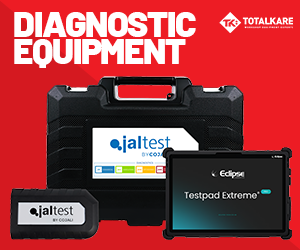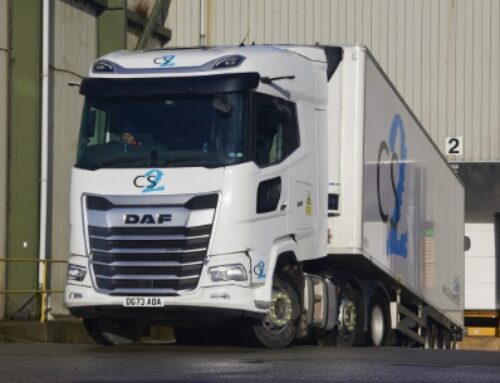Predictive maintenance in the conference spotlight
The changing economics and technology of fleet maintenance were explained to the Logistics UK Fleet Engineer conference by John Armes, the digital services manager at Daimler Truck (formerly Mercedes-Benz). His theme was the benefits of predictive maintenance, and how fleet engineers could use it to reduce cost and increase vehicle availability.
He started by admitting that the most profitable part of a Daimler Truck dealer’s business was the workshop. The dealer network was also Daimler Truck’s public face.
“Most dealer workshops are open 24/7 and are currently operating at 100 per cent capacity,” he claimed.
Daimler had launched a digital service, branded as My TruckPoint: this was provided free for the life of new trucks. At launch it incorporated two services: live traffic and live maintenance management. Two additional services were due for launch this year: ‘flash over the air’ and a breakdown service.
The next step up from this was TruckLive, which bundled up Daimler’s digital services into an easy-to-understand package: it could be upgraded at additional cost to include Daimler’s Uptime and Fleetboard platforms.
It was free because it gave Daimler an opportunity to harvest operational data (with the operator’s consent). The payback for Daimler was data collected could be used to inform the manufacturer’s R&D department for use in enhancing product specification and in performance monitoring and improvements.
Operators had to opt into it “because we need a legal contract in order to supply its services, especially where we connect customer data,” he explained.
On the road, drivers benefited from the Live Traffic service which fed real-time information into the truck’s navigation system. “This provides dynamic routing and more accurate arrival time estimations,” he said.
The live maintenance management service allowed the workshop to see what items were coming up for attention prior to a truck’s scheduled workshop visit. It could be regarded as the basic version of Daimler’s premium Uptime paid-for service.
Faults were categorised into “things you can do, and things the dealer can do”.
An example of the former might be an exhaust filter that required regeneration, and the latter an exhaust filter that required removal and reconditioning or replacement.
“If there’s a serious issue, for example a brake failure, then the driver is alerted by a warning light, the customer gets an alert on the system, and the dealer also gets an alert and makes a phone call to the customer.”
Less dramatically it also “reports vehicle status: AdBlue and fuel level, oil pressure, and brake wear expressed as a percentage. Tyre pressure monitoring (TPMS) is also available.”
John Armes also gave a preview of the soon-to-be introduced S24H Breakdown Service.
“This guarantees to get a technician to your vehicle within an hour,” he promised.
But the fault diagnosis would start before then, as “the vehicle will do a remote fault diagnosis and send its location to the dealer. The attending technician is given the vehicle’s location, and suggestions as to what parts will be required to repair it.
“We can decide whether the technician attempts a roadside repair, or if a recovery to the workshop is required.”
The system would allow a higher roadside fix ratio, as the technician would arrive prepared with the necessary parts and go straight to the location thanks to GPS data.
It was also easier for the operator to report a breakdown online via My TruckPoint, he said, as most fields on the online form would already be completed. But the customer could add a fault description, and also upload an image of the fault.
“It will be possible to update digital systems over the air, and perform software updates on the truck itself while the vehicle is on the road. This is all coming in the next two months,” John Armes promised. Operators would receive information about the planned updates via My TruckPoint, and drivers would be guided through the process to ensure the vehicle is in a proper state and they have sufficient time for the process.
Uptime is a service that has been offered since 2019, and it is included in Mercedes-Benz service contracts. Data is collected from connected vehicles and used to create specific instructions and advice for customers and workshops. This data enables pre-emptive action to be taken to avoid breakdowns, and minimise and optimise workshop visits.
“Dealers have to have a workshop bay dedicated to Uptime,” John Armes said. “Currently 70 per cent of Mercedes-Benz trucks are on Uptime, and it’s very easy to set up.”
The rollout of electric trucks did not mean that workshops would become empty, but it did mean that remote monitoring and repair would become even more important. “Electric trucks have multiple thousands of sensors,” Mr Armes said.
On a related theme, Neil Unadkat, CTO of Intangles, said the rise of IT would facilitate predictive maintenance. Most unscheduled work was currently done on a reactive basis, he said: a warning light was illuminated and a workshop investigation triggered. But increasingly, the condition and use of vehicles would be monitored in real time and problems dealt with proactively, leading to fewer breakdowns, lower workshop costs and safer operations.
Breakdowns could be reduced by 75 per cent, and vehicle availability increased by between 10 and 30 per cent. Driver behaviour could be improved by 20 – 30 per cent.
Mr Unadkat gave the example of a truck’s intercooler developing a small leak. The driver might not report, or even notice, a slight decline in maximum power until the problem became really serious, but it would be picked up far earlier by intelligent monitoring of the truck’s performance, which would compare induction tract pressures to a mass of assembled data and identify a deviation from normal parameters.
He raised the ever-thorny issue of DPF regeneration. The system would monitor passive regeneration ‘events’ not just in number but also in effectiveness. Some vehicles had repeated regenerations which failed to clear the particulate filter because the vehicle was never driven long enough at high enough speeds for sufficient heat to be generated in the filter. The system would suggest that, for example, the vehicle was driven at over 40 mph for over an hour to clear the filter, rather than immediately taking it off the road to perform an active regeneration or a filter clean/change.
Intangles’ system would run in the vehicle, rather than being held ‘in the cloud’.
“It gives the driver information fast, while telematics in the cloud gives it last,” he quipped.
Ashley Connell, commercial director of software platform r2c, told the conference how legislative compliance and workshop and fleet management could be improved by using his company’s service to link vehicle checks and inspections with workshop activity and parts ordering.
Services offered by r2c include vehicle maintenance, truck compliance, and vehicle rental and remarketing.
Its compliance checks didn’t just cover vehicle condition, he said but also ULEZ and Transport for London’s Direct Vision Standard, annual tests, and drivers’ hours.
The services were all interlinked. For example, if a driver’s daily check was made using the r2c app and recorded a defect then the transport manager would receive an automatic alert, a jobsheet would be created at the workshop, and the rectification work would be authorised.
As vehicles became more automated, so did the r2c process. For instance, when a vehicle’s service light came on or a brake warning light was illuminated this would trigger the creation of a workshop job sheet and an order for the necessary parts automatically.
“If a defect is raised, it can’t be signed off without a rectification job being activated,” Ashley Connell explained.















